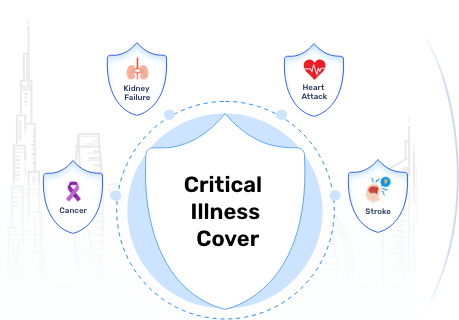800 800 001
Critical Illness Rider Vs Standalone Policy
Understanding the difference between a critical illness rider and a standalone policy is essential when choosing the right insurance plan in the UAE. Both options offer financial protection in case of a serious illness, but they cater to different needs and priorities.
A critical illness rider is an add-on to your main insurance policy such as life or mortgage insurance, offering basic coverage at a lower cost. It’s a convenient option for those looking for affordability and quick approval. However, riders typically provide limited flexibility and lower coverage amounts.
On the other hand, standalone critical illness insurance is a separate policy designed to offer better coverage and customisation. It is ideal for those with significant financial responsibilities or the need for more comprehensive protection. Understanding these key differences will help you make an informed decision based on your health, lifestyle, and financial needs.
Buy Critical Illness Insurance Plans In UAE
What is Critical Illness Insurance?
Critical illness insurance provides a lump-sum payment if you are diagnosed with a serious illness. The benefit amount can be utilised for various needs such as —
- Medical care, including at-home or specialised treatments
- Prescription medications
- Other treatment-related expenses
- Home modifications
- Paying off debt
- Replacing lost income
- Covering daily living costs
- Managing other financial obligations and more
Most standalone critical illness policies cover major health conditions like cancer, stroke, heart disease, multiple sclerosis, and more. If diagnosed with a covered illness, the policy provides a one-time lump-sum payment that can be used as needed.
What are the Benefits of Critical Illness Insurance?
Here are the key benefits of a critical illness standalone policy —
- You get a lump sum payment to cover major critical illnesses
- Comprehensive benefit — The insured receives a lump sum amount upon being diagnosed with a critical illness — this amount can be used for any purpose including settling debt, covering treatments, or maintaining a lifestyle
What is a Critical Illness Rider?
A critical illness rider is an optional add-on to your primary insurance policy, often added to life insurance for extra coverage. It can also be added to other policies like mortgage or disability insurance.
While it provides coverage for major illnesses, it typically offers fewer benefits than a full critical illness policy. A rider may cover fewer health conditions and provide a lower payout compared to a standalone critical illness plan.
What are the Benefits of Critical Illness Rider?
Mentioned below are the major benefits of critical illness rider —
- Usually, there are no separate underwritings — the rider comes with the underwriting of the base policy
- Along with the critical illness rider, you can add other rider(s) to make the policy more comprehensive
Difference Between Critical Illness Rider and Standalone Policy
The table below highlights the key differences between a critical illness rider and a standalone policy —
| Basis | Standalone Critical Illness Policy | Critical Illness Rider |
|---|---|---|
| Definition | Independent policy that emphasises critical illness coverage | Rider on the base life or term insurance plan that covers particular critical illnesses |
| Policy Duration | Specific period | Mostly tied to the principal policy and expires along with the base policy |
| Customisation | Flexibility in choosing cover and policy terms | Limited scope of customisation and is based on the base policy |
| Sum Assured | The amount depends on your specific policy and requirements | The amount cannot be more than the base policy sum assured |
Critical Illness Rider vs Standalone Policy: Which is Better?
Deciding between a rider or a standalone critical illness policy depends on your needs and priorities such as coverage amount, cost, and flexibility. Here's a breakdown to help you choose.
Consider a critical illness rider if:
- You're buying life insurance and want to add critical illness coverage at the same time
- You prefer lower-cost coverage
- You need quick approval
- You’re fine with basic coverage and don't need high limits or extra features
Choose standalone critical illness insurance if:
- You need extensive coverage, especially if you have high income or significant debt
- Flexibility to customise your policy is important
- You already have life, mortgage, or disability insurance but want critical illness coverage separately
- You don’t want your life insurance payout reduced if diagnosed with a critical illness*
- You’re willing to spend more for comprehensive coverage
*This type of reduction in life insurance payout happens in the case of accelerated critical illness ride
More From Critical Illness
- Recent Articles
- Popular Articles
















